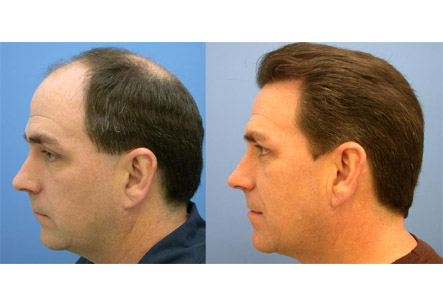Hair Implants
Introduction
For some individuals a thick head of hair may be the ultimate dream and hair implants may be a good solution for these individuals. Various forms of hair transplantation surgery have been used in the United States and worldwide since the 1950s. There are some newer techniques to restore hair surgically. These include Follicular Unit Transplantation, Follicular Unit Micro Grafting, or Follicular Unit Extraction.
Surgical Technique
Usually the hair at the back of the head is resistant to balding due to excessive testosterone. Testosterone is the male hormone that is said to be responsible for the characteristic pattern of hair loss at the front of the scalp seen in men. At present this testosterone resistant hair from the back of the patient’s own scalp is transplanted into the balding areas in the front. Alternatively this transplant may occur between identical twins. If hair is taken from different individuals the patient might need to take medications so that their body does not reject the transplanted hair considering it foreign. For men and women who have a more distributed hair loss all over the head, transplant from donors may be needed.
We have all the information you need about public and private Cosmetic / Plastic clinics that provide Hair Loss Treatment in Iran, Islamic Republic Of with the best quality and lowest possible price

During surgery the scalp is rendered numb to sensation using a local anesthetic. For this multiple injections of the local anesthetic drug along the hair line all around the scalp may be needed. Once the hair is extracted it is transplanted to the balding parts after creating tiny slits on the scalp surface. The donated hair, hair follicles, surrounding tissue, and skin are called grafts, and each graft contains one or more hair follicles with accompanying hair, tissue, and skin.
Hair density refers to the number of hair follicles per square centimeter of scalp. A related factor is scalp laxity, the flexibility and looseness of the scalp. More grafts of hair can be transplanted if the hair density is high and the scalp laxity is high.
Recovery and post operative considerations
The procedure needs to consider potential for further hair loss in future. Depending on initial and later hair loss rates the number of procedures is decided. Women may need more number of sessions and follow up than men. At the first visit after hair implants surgery the head needs to be examined throughly. The doctor may use an instrument called the hair densitometer, which measures hair density.
Like any surgical procedure hair transplantation also carries a risk of bleeding, infections, pain and other complications. Most of these may be resolved using appropriate medications. Caution with the comb in the initial few days may be necessary. Patients are forbidden to apply any pressure or pull at the hair roots during the recovery phase. Tight clothes that need to be worn and removed over the head are also discouraged. Hair colour and other irritants also need to be restricted till recovery is complete.